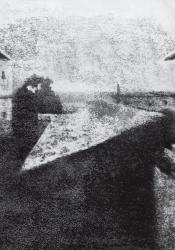Invention of Photography
The invention of photography opened a new chapter in the history of printing and communication. It’s been quickly replaced instead of painting, wood, and metal engraving in the printing process. Precision, speed, and accuracy were the main characteristics of photograph versus other techniques. Photography could take printing techniques to a higher level of quality and quantity. Tone separation and increasing the tonalities were some achievements that were the most accurate and precise printing technique in the mass printing industry and especially printing media like magazines. Joseph Nicéphore Niépce made the first photograph in 1827 in Le Gras in Burgundy region of France through the window of his small lab. It took 8 hours to record the image on a light-sensitive metal plate. After him, Louis-Jacques-Mandé Daguerre in 1839 made a faster and sharper image on metal named daguerreotype. Two years later in London Fox Talbot made the first photograph on paper named Calotype or Talbotype. However, the first photograph that could be published in a magazine was 'Barricades on rue Saint-Maur'. This photo published in L’Illustration in July 1848 by engraving technique.
Bibliography:
Rosenblum, Naomi, and Diana C. Stoll. A World History of Photography. Abbeville Press Publishers, 2019.
https://www.metmuseum.org/toah/hd/lith/hd_lith.htm
https://journals.openedition.org/etudesphotographiques/347
https://en.wikipedia.org/wiki/Photojournalism
https://www.oldbookillustrations.com/techniques/
https://www.oldbookillustrations.com/dictionary/contents/index

